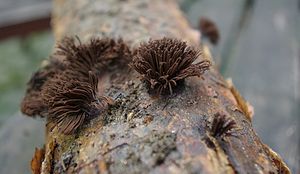Stemonitis
| Stemonitis | ||||||||||||
|---|---|---|---|---|---|---|---|---|---|---|---|---|

Dark thread knot ( Stemonitis fusca ), the type species of the genus |
||||||||||||
| Systematics | ||||||||||||
|
||||||||||||
| Scientific name | ||||||||||||
| Stemonitis | ||||||||||||
| Gled. |
Stemonitis , also sometimes called thread dusters in German, is a genus of slime molds from the order Stemonitida .
features
The fructifications are stalked and elongated, cylindrical in shape. They grow tightly packed or bundled in groups. The membranous base ( hypothallus ) is membrane-like and well developed. It is located together under the individual fruiting bodies. The stem is present and hollow in all species. In transmitted light it appears red-brown to black-brown. It always goes into the Columella . This usually runs to the tip of the fruiting body, where it usually branches into the scalp . The columella also appears red-brown to black in light transmitted through it.
The covering peridia disappears when the fruiting bodies ripen and can hardly be observed. The capillitium arises from the entire length of the columella. It forms a more or less large-meshed, three-dimensional network and appears dark to light brown in the transmitted light. At the branch points, the fibers often run into one another widely. On the surface, the scalp changes into a two-dimensional network.
The spores appear in mass rust-brown or dark-brown to black, in the transmitted light violet-brown, gray-brown, brown, red-brown to almost colorless. The plasmodium is colored white, yellow or green-yellow.
The type species is the dark thread cone ( Stemonitis fusca ).
Generic delimitation
The genera Stemonitopsis , Stemonaria and Comatricha are closely related to Stemonitis . The latter always has typically hollow, homogeneous stems and a complete surface network. In Stemonaria and Comatrichia there is none and in Stemonitopsis a fragmentary surface network. The stem is fibrous in Comatrichia and Stemonitopsis , in stemonaria it is mostly homogeneous.
Systematics
The genus Stemonitis comprises around 20 species worldwide. Around ten species are specified for Central Europe :
- Stemonitis axifera
- Stemonitis favoginea
- Stemonitis foliicola
- Stemonitis fusca
- Stemonitis herbatica
- Stemonitis laxifila
- Stemonitis lignicola
- Stemonitis pallida
- Stemonitis smithii
- Stemonitis splendens
swell
literature
- Hermann Neubert , Wolfgang Nowotny , Karlheinz Baumann , Heidi Marx: The Myxomycetes of Germany and the neighboring Alpine region with special consideration of Austria . tape 3 : Stemonitales . Karlheinz Baumann Verlag, Gomaringen 2000, ISBN 3-929822-02-4 .
Individual evidence
- ^ Hermann Neubert , Wolfgang Nowotny , Karlheinz Baumann , Heidi Marx: The Myxomycetes of Germany and the neighboring Alpine region with special consideration of Austria . tape 3 : Stemonitales . Karlheinz Baumann Verlag, Gomaringen 2000, ISBN 3-929822-02-4 , p. 268 .